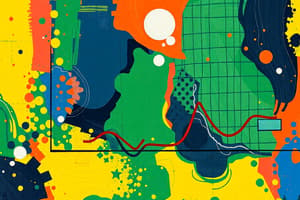Podcast
Questions and Answers
What is demand in Economics?
What is demand in Economics?
Demand in Economics refers to a desire backed by willingness and ability to pay for a good or service.
Demand = ______ + willingness to purchase + ability to pay.
Demand = ______ + willingness to purchase + ability to pay.
Desire
Demand schedule shows the relationship between price and quantity supplied of a commodity.
Demand schedule shows the relationship between price and quantity supplied of a commodity.
False (B)
Individual demand refers to the quantity of a commodity demanded by all consumers in the market at a given price.
Individual demand refers to the quantity of a commodity demanded by all consumers in the market at a given price.
What is the relationship between price and quantity demanded shown by an individual demand schedule?
What is the relationship between price and quantity demanded shown by an individual demand schedule?
What does a downward-sloping demand curve indicate?
What does a downward-sloping demand curve indicate?
What is the key difference between individual demand and market demand?
What is the key difference between individual demand and market demand?
Market demand curve can be obtained by horizontally adding all individual demand curves.
Market demand curve can be obtained by horizontally adding all individual demand curves.
Which of the following factors can influence the demand for a good?
Which of the following factors can influence the demand for a good?
What is the 'Law of Demand'?
What is the 'Law of Demand'?
What are the assumptions on which the law of demand is based?
What are the assumptions on which the law of demand is based?
Giffen's paradox is an exception to the law of demand, where the demand for a good increases as its price increases.
Giffen's paradox is an exception to the law of demand, where the demand for a good increases as its price increases.
What are the key factors that cause 'expansion of demand'?
What are the key factors that cause 'expansion of demand'?
How is 'contraction of demand' different from 'decrease in demand'?
How is 'contraction of demand' different from 'decrease in demand'?
Increase in demand implies a shift of the demand curve to the right, indicating a greater demand at all price levels.
Increase in demand implies a shift of the demand curve to the right, indicating a greater demand at all price levels.
What are the key differences' between 'aggregate demand' and 'demand'?
What are the key differences' between 'aggregate demand' and 'demand'?
Which of the following is an example of a 'prestige good'?
Which of the following is an example of a 'prestige good'?
Flashcards
Demand
Demand
A desire backed by willingness and ability to pay for a commodity.
Individual Demand
Individual Demand
The quantity of a commodity a single consumer demands at a given price.
Market Demand
Market Demand
The total demand for a commodity from all consumers at a specific price and time.
Demand Schedule
Demand Schedule
Signup and view all the flashcards
Demand Curve
Demand Curve
Signup and view all the flashcards
Inverse Relationship (Demand)
Inverse Relationship (Demand)
Signup and view all the flashcards
Law of Demand
Law of Demand
Signup and view all the flashcards
Giffen's Paradox
Giffen's Paradox
Signup and view all the flashcards
Prestige Good
Prestige Good
Signup and view all the flashcards
Speculation
Speculation
Signup and view all the flashcards
Price Illusion
Price Illusion
Signup and view all the flashcards
Habitual goods
Habitual goods
Signup and view all the flashcards
Expansion of Demand
Expansion of Demand
Signup and view all the flashcards
Contraction of Demand
Contraction of Demand
Signup and view all the flashcards
Increase in Demand
Increase in Demand
Signup and view all the flashcards
Decrease in Demand
Decrease in Demand
Signup and view all the flashcards
Determinants of Demand
Determinants of Demand
Signup and view all the flashcards
Income
Income
Signup and view all the flashcards
Substitute Goods
Substitute Goods
Signup and view all the flashcards
Complementary Goods
Complementary Goods
Signup and view all the flashcards
Composite Demand
Composite Demand
Signup and view all the flashcards
Competitive Demand
Competitive Demand
Signup and view all the flashcards
Direct Demand
Direct Demand
Signup and view all the flashcards
Indirect Demand
Indirect Demand
Signup and view all the flashcards
Study Notes
Demand Analysis
- Demand is the desire backed by the willingness and ability to pay for a commodity.
- Utility is the basis of demand, desire or need to have a commodity.
- Demand schedule is a table showing the relationship between price and quantity demanded.
- Individual demand schedule shows the quantity of a commodity a consumer is willing to buy at various prices.
- Market demand schedule shows the total quantity of a good demanded by all consumers at different prices.
- Individual demand curve graphically represents the relationship between price and quantity demanded by an individual.
- Market demand curve is a horizontal summation of individual demand curves.
- The demand curve slopes downward, illustrating an inverse relationship between price and quantity demanded.
Meaning of Demand
- Demand in everyday language refers to a desire.
- In economics, demand is a desire backed by the willingness and ability to pay.
- Demand is an effective desire; all desires are not demands.
- Demand must have all three elements: desire; ability to pay; willingness to purchase.
Determinants of Demand
- Price: Higher price, lower quantity demanded; lower price, higher quantity demanded.
- Income: Higher income leads to higher demand for normal goods; lower income leads to lower demand for normal goods.
- Prices of related goods (substitutes and complements): Substitute goods (e.g., coffee and tea); the price of one good affects the demand for the other. Complement goods (e.g., car and fuel).
- Tastes and preferences: Consumer preferences influence demand.
- Consumer expectations: Expected price changes affect current demand (e.g., expecting a price rise will lead to more purchases now).
- Size of population and consumer composition: Population size is a key factor.
- Advertising and marketing: Marketing efforts influence demand.
- Government policies: Government policies impact the demand for certain goods.
- Fashion, habits, tastes: Consumer preferences, including fashion trends or habits influence demand.
Exceptions to the Law of Demand
- Giffen goods: Inferior goods for which demand increases as price increases (e.g., inferior staple foods).
- Prestige goods: Luxury goods for which demand increases as the price increases (e.g., luxury cars).
- Speculation: Goods that are expected to increase in price will see increased demand.
- Price illusion: Consumers assume higher-priced goods are of better quality.
- Ignorance of substitute prices: Consumers may not be aware of the lower price of substitute products.
- Habit and custom: Demand for certain goods persists due to habit and custom, despite price increases (e.g., nicotine).
Types of Demand
- Direct demand: Refers to consumer goods (directly purchased)
- Indirect demand: Refers to intermediate or producer goods (needed for further production).
- Joint demand: The simultaneous demand for two or more goods, used together (e.g., fuel and car).
- Composite demand: Demand for a good with multiple uses (e.g., electricity).
- Competitive demand: Demand for goods that can be substituted (e.g., tea and coffee).
Expansion and Contraction of Demand
- Expansion of demand: An increase in the quantity demanded due to a fall in price of the good (holding all other factors constant). It moves along the demand curve.
- Contraction of demand: A decrease in the quantity demanded due to an increase in the price of the good (holding all other factors constant). It moves along the demand curve.
Increase and Decrease in Demand
- Increase in demand: An upward shift of the demand curve due to factors other than the good's own price (e.g., taste, income).
- Decrease in demand: A downward shift of the demand curve due to factors other than the good's own price (e.g., tastes, income).
Market Demand Analysis
- Market demand refers to the total demand for a commodity at a given price point during a particular period.
- The market demand schedule specifies the total quantity demanded at various prices.
- Market demand curve is derived by summing the demand curves of all individual consumers at each price.
Studying That Suits You
Use AI to generate personalized quizzes and flashcards to suit your learning preferences.




